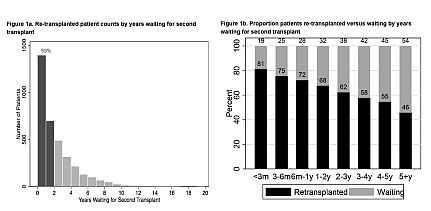Revisiting the Second Kidney Transplant in Children
Department of Pediatric Nephrology &
Hypertension, University of Texas Health Science Center at Houston (UTHSC), Medical School, Houston, TX
Division of Immunology &
Organ Transplant, UTHSC, Medical School, Houston, TX
Meeting: 2013 American Transplant Congress
Abstract number: C1426
Purpose: To describe the path of children after primary transplant (tpx) failure and determine factors influencing the probability and wait times for second tpx.
Methods: Retrospective review of SRTR/UNOS tpx records from 1987-2010 in children who received a single-organ kidney tpx when < 20 yrs.
Results: Of 7,248 primary tpx failures in children (median age 14), nearly half (47%) were not re-transplanted. Mortality of re-transplanted (4%) was similar to those on wait list (3%) and double those not re-listed (8%). The majority (59%) of 3,716 second tpx occurred within first 2 yrs of re-listing; 39% re-transplanted within 12m and 24% re-transplanted within 6m(Fig1a). The odds of receiving second tpx decreased 16% for each additional year on wait list (p<.001). Of those waiting >5 years, less than half (46%) received a second tpx(Fig1b).
Living donor (LD) and cadaveric donor (CD) sequence significantly influenced wait times to second tpx and combined wait times to primary and second tpx. Of those who received a second tpx, LD-LD and CD-CD had the shortest and longest wait times, respectively. While expected LD-CD had longer wait for second tpx compared to CD-LD, surprisingly combined primary and second wait times were significantly longer for LD-CD vs CD-LD(Fig2). Other factors that significantly increased wait times to second tpx were older age at primary tpx, non-white race, and primary or secondary PRA ≥ 80% (p<.05).
Conclusions: Many children have difficulty receiving a second tpx after primary failure. The likelihood of re-transplantation is strongly affected by time on wait list and donor source sequence. This study confirms the use of LD in secondary tpx after CD in primary tpx as a viable option in children.


To cite this abstract in AMA style:
Bell C, Angelo J, Bynon J, Swinford R. Revisiting the Second Kidney Transplant in Children [abstract]. Am J Transplant. 2013; 13 (suppl 5). https://atcmeetingabstracts.com/abstract/revisiting-the-second-kidney-transplant-in-children/. Accessed July 18, 2025.« Back to 2013 American Transplant Congress
